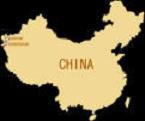By John Wyckoff
Recent articles such as this one and this one examine a dynamic that will affect just about every small and large business in America.
One article talks about the decimation of the U.S. furniture industry. The other examines a similar effect in the textile industry. Both industries in the United States are being severely impacted by China.
Furniture making in the U.S. has been a very stable industry. Most wooden furniture has been made in the Carolinas, until now. Enter Chinese-made wooden furniture. They have the quality and technology. Today, many of the well-known furniture brands import components or completed furniture from China. They repackage it and sell it to their dealers.
The Southeastern part of the U.S. was also known for its textiles. Now that the quotas have been removed from Chinese textiles you can expect to see the vast majority of clothing sold in this country to be made in China. The textile mills in the Southeast will, more than likely, shrink in number as will those engaged in textile production.
 The agriculture industry is also being impacted. China is no longer the prime target of U.S. agricultural product exports. They've learned how to produce more using technology we gave them. Today, they are exporters of grain rather than importers.
The agriculture industry is also being impacted. China is no longer the prime target of U.S. agricultural product exports. They've learned how to produce more using technology we gave them. Today, they are exporters of grain rather than importers.
I had an opportunity to visit with a friend who is a quality control consultant. He'd just returned from China where he was contracted by a Chinese automaker interested in entering the U.S. market with line of Chinese made automobiles. His job was to assure the maker that the quality of their product would be equal to the quality of Japanese automakers. He told me they have the technology and understand. He went on to say when their autos are exported to the U.S. they will sell for about 20 to 30 percent less and have quality equal to or better than that which is available from Japan.
Being in the powersports industry I'm aware of the impact being felt by retailers, as they are inundated by Chinese makers of ATVs, scooters, pocketbikes and motorcycles. Some of these products have reasonable quality; some don't.
Here's what I suggest you consider. There's no way any industrial nation can compete with a country whose workers average 61- cents per hour and whose engineers (who were educated in this country), work for the equivalent of $100 a week. With so many American manufacturers partnering with Chinese makers in order to control costs, the Chinese makers are gaining the advantage of technology given to them by their partners.
What to do? Look at what's available from China and determine if the maker has the necessary financial wherewithal, insurance, quality and warranty to meet your business philosophy. Understand that there will be a disorderly marketplace and a great deal of angst while the market changes.
China represents a freight train heading straight for you. Don't stand in front of it in an attempt to stop it. Instead, you would be better served if you did your research and then found a way to hop on. Accept the fact that it may be a bumpy ride at the beginning.
Keep in mind that Wal-Mart currently purchases more products from China than England and Russia combined. That's just one customer. Wal-Mart's success can be attributed, at least in part to their ability to buy Chinese goods at more than competitive prices.
Here's where I'll step out and make a prediction: I predict that China will, within five years, be the equal of Japan in providing quality products to the U.S. I'm not saying I like it but unless there are strategic changes in import regulations I don't see anything that will alter that paradigm.
 Like this article? Read more by John Wyckoff:
Like this article? Read more by John Wyckoff:
Powersports Industry Trends for 2005
How Harley Davidson Lost its "Cool"
And be sure to check out his new book, Mind Your Own Business, 2nd Edition.
No comments:
Post a Comment